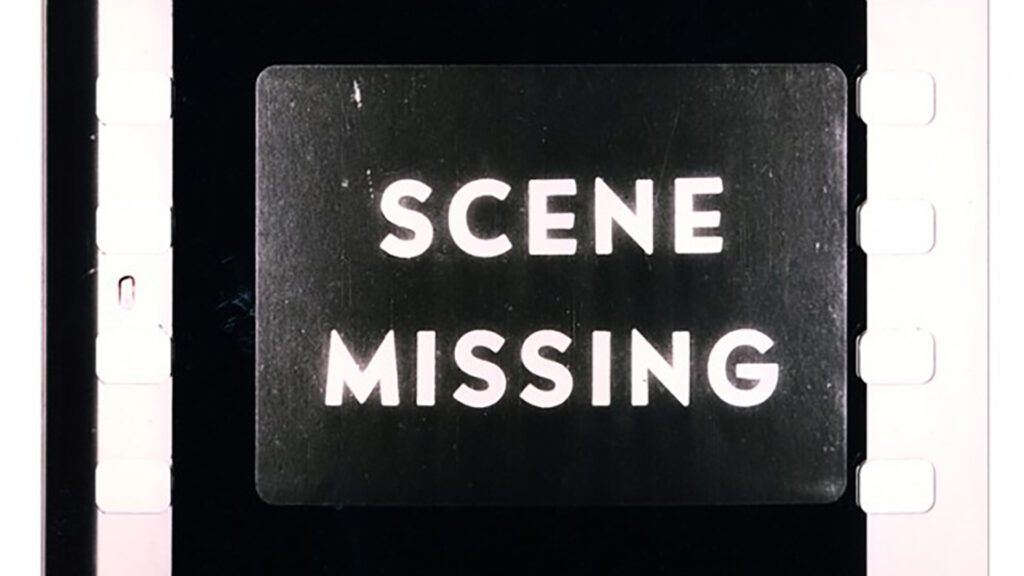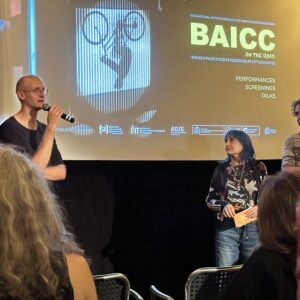We reproduce a fragment of Scott MacDonald’s interview with Morgan Fisher talking about his work in commercial cinema and how it took him to his film Standard Gauge.

Scott MacDonald: I was surprised to learn that you had worked on commercial features with Roger Gorman and Haskell Wexler.
Morgan Fisher: I would have thought it was apparent from my films that I had some kind of relationship with the Industry at the practical level. The Industry has always been important for me. I became interested in filmmaking in the middle sixties, when Film Culture presented articles about the New American Cinema and films made in Hollywood on an equal footing. In the same issue were stills from Flaming Creatures and the opening sequence of The Naked Kiss, where Constance Towers beats up her pimp. That was a golden moment. The unifying idea was that of being an artist in film, no matter where. There was also the implication, which I think is correct, that what independent films and commercial films have in common is as important, or perhaps more important, than what divides them. Soon afterwards the critical politics of the magazine shifted, and except for some old films that were enshrined in history, commercial films were dismissed as being unspeakable. This is an orthodoxy that I feel hasn’t done much good. In my work I have tried to acknowledge the unalterable fact of the Industry, which there is no getting around, and to maintain an openness toward what it is and what it has given us. I regard the Industry as a source of ideas and material, as a subject, and in some ways as a model, even though I also criticize it.
But at any rate, during the early seventies I worked as an editor on low budget features. I was the second editor on The Student Nurses [1970] for which Roger Corman was the executive producer. It was his first film, I think, after he formed New World. But I worked under him, not with him, since I saw him only when we screened the cuts. Later on I was the editor of an independent feature called—it had three titles— The Second Coming, Blood Virgin, and Messiah of Evil, the title under which it was finally released [in 1975]. It was a horror film, need I say, and was intended as a straightforward exploitation programmer. I did some second-unit directing, and I also had a bit part in the film opposite Marianna Hill. (She had been in Red Line 7000 and later played the wife of Fredo in The Godfather I.) In my scenes with her I play an assistant in an art gallery. She comes in looking for her father, a painter who’s gone mad and has vanished, and I try to throw her off the track. I wear the same suit that I later wore in George Landow’s On the Marriage Broker Joke [as Cited by Sigmund Freud in ‘‘Wit and its Relation to the Unconscious” or Can the Avant-Garde Artist Be Wholed?].
Messiah of Evil had a commercial release, but it was withdrawn after an abbreviated run because of legal problems. In Los Angeles it played at a big popcorn theater downtown, where for the first and only time I saw the film with a real audience. The atmosphere was similar to the theaters on 42nd Street. I sat behind a large woman whose responses to the film were quite vocal. When I had done my scene I was nervous, so I was pale and my voice trembled. But it turned out that these seeming flaws in my performance fitted perfectly with the spooky weirdness that was the intended effect of the scene. When I came on the screen, I had the pleasure of hearing this woman in front of me say, in this genuinely feeling tone, “That guy gives me the creeps.”
I’ve heard a rumor that the film was rereleased under still another title, but again only briefly. I don’t think it’s in distribution anymore. Among people who’ve managed to see it, it’s become something of a cult film. In a poll published in Film Comment in 1976, several dozen British film figures, mostly critics, were asked to name their twelve favorite films of all time, and two of them mentioned Messiah of Evil. Someone else named Eadweard Muybridge, Zoopraxographer [1975], the documentary by Thom Andersen that I worked on as editor and general collaborator. The Muybridge film was also listed by two critics in the 1976 Sight and Sound poll of the ten best films released that year in Great Britain.
For Haskell Wexler I was a stock footage researcher for a couple of weeks, for a feature that never materialized. It was supposed to be the next film after Medium Cool. I was looking for scenes of people dying violent deaths, and one of the shots I found was in Bruce Conner’s A Movie, the execution scene where the man is sitting in a chair with his back to the firing squad. According to the microfilm at the stock-footage library, he had been the warden of a prison in fascist Italy. The motif of fascism in A Movie is very pronounced, but in anything I’ve ever read about the film, that’s gone unmentioned. It’s an extremely powerful and seductive film. People must realize what it is they’re responding to and don’t want to face it in the film because that would mean having to face it in themselves. And A Movie is the one independent film that everyone likes. The film plays on destruction as spectacle, and it’s haunted by a kind of dreadful euphoria, and Mussolini is in the film, dead. And the music, The Pines of Rome by Respighi, is related to fascism, and in a double sense. As I understand it, Respighi was associated with fascism at the level of organized politics, though whether as a matter of expedience or out of conviction, I don’t know. And the music is program music, which can be called fascist in an extended or poetic sense (if that isn’t a contradiction), since it’s intended to describe specific scenes, that is to say, to pre-empt your reaction to it, to control you, because there is only one correct response. Conner’s method as a filmmaker—found footage and collage—is one of the subjects of a film I’m working on [Standard Gauge]. It’s an autobiographical sketch of the time I’ve spent in the Industry, organized around pieces of 35mm film that I’ve scavenged over the years. It’s all found footage, but instead of being brought to life by projection, as in Conner’s films, it’s presented as inert material, as separate strips of film. It’s like show and tell, a picture album with an extended commentary. The material is vastly miscellaneous so it lets me talk about all kinds of things, but the underlying subject of the film is the Industry.
MacDonald: You’re making it in 35mm?
Fisher: No, it’s in 16mm, but all you see are pieces of 35mm, one after another. It’ll be a little bit like Production Stills in that it’s literally a spatially and temporally continuous shot, within which a series of disjunctive visual events is presented. Another of the film’s subjects is gauge and what it implies: the complex of economic activity that gives rise to an Industrial standard and afterwards is a further consequence of that standard, and the fact that gauge unifies films of every kind. Gauge is one of the unexamined facts of film. There are only a few gauges, and every film is on, or in, one or another of them. No independent filmmaker, however committed to the ideal of the personal and the artisanal and the poetic, makes his or her own raw stock; you work with what large-scale Industrial enterprise gives you. There are organizations such as the Society of Motion Picture and Television Engineers that exist for the sole purpose of setting dimensions and standards for the Industry, and they set these standards to the thousandth part of an inch. Every film is embedded in, or interwoven with, the same material form. As Bruce Conner has shown, this means that any film can become a part of any other film in a way that is utterly direct. The material sameness of all film and, as a corollary, the sameness of the process by which it is presented to us, namely projection, have theoretical implications that should not be overlooked.
And since the film will show you pieces of film, strips of translucent celluloid, it brings up the question of film as an object. Unlike videotape, for example, film has a dual identity. When you look at a piece of videotape, no information is visible; it’s encoded within the material in such a way that it can be interpreted only by a machine. The format of film is equally prescribed, but if you pick up a piece of film, there’s something to look at. Film can to some degree be read, experienced directly, without a machine, at the level of inert material. An awareness of the material base of film dominates our thinking about it. Sprocket holes are not a part of what we see when a film is projected, and yet we know they’re there. They are, in fact, the universal emblem of film, as almost every film festival poster attests. And yet sprocket holes don’t stand just for the physical medium but for the idea of movie-ness in the broadest sense: theaters, projection, sitting in the dark, the succession of frames, watching an image, any image, the entire potential of film.





